Up a skinny stairwell in New York City’s Chinatown on a sweltering late-September night, a private dining room overflowed with downtown cool kids. Some were sipping Recess, the CBD-infused sparkling water in distinctive pastel cans whose ads papered New York subway walls for a brief period earlier this year. Others stood in the open kitchen, making their own ravioli, which were then placed into plastic to-go boxes marked with each person’s name: the promise of a weeknight dinner at home.
The jumpsuited and overalled and fashion-forward mom-jeans-wearers were there to celebrate the ongoing launch of Equal Parts, the first of many planned brands from a new (and newly philosophical) company called Pattern. Equal Parts sells “modern” cookware (sturdy frying pans, mixing bowls, spatulas, knives, and a cutting board turned charcuterie plate) accompanied by cooking assistance. At the party, hip millennial cooks hovered nearby to answer partygoers’ questions, but when you purchase Equal Parts cookware, help comes via text message from friendly “coaches” ready to guide you through making a quick dinner when all you have in your kitchen is a can of black beans, some peanut butter, and a bottle of Trader Joe’s wine.
In its previous incarnation, Pattern was a hip boutique digital marketing agency called Gin Lane, responsible for the look of some of the most prominent brands in today’s bourgeois millennial marketplace: Sweetgreen, Harry’s, Everlane. They were trendsetters who made fast-but-fancy salad happen and normcore sustainable clothes cool. Events like the one in Chinatown are the sort of thing that Gin Lane had perfected: gathering cool kids who could help a product, an aesthetic, or a lifestyle choice spiral forth into the world through their Instagram accounts.
There was a lot to be wary of in that loft: the beautiful people; the gift bag, complete with butcher knife; the photo booth and the invitation to share photos from the night “with your community”; the guy with the T-shirt that read “Due to Physical Violence Shitfaced Mondays Have Been Canceled.”
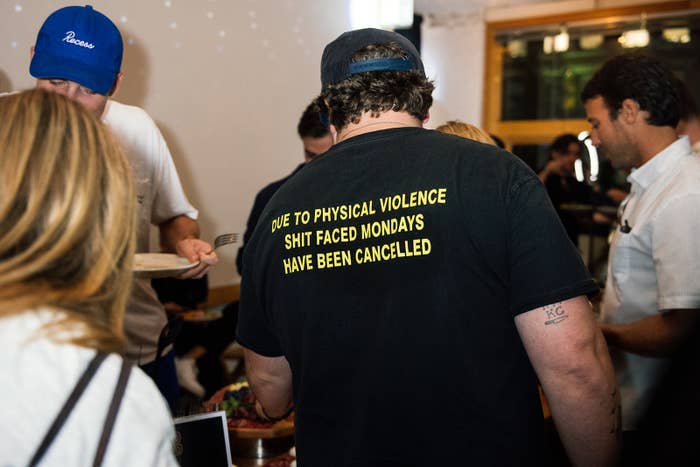
I’d first felt that wariness back in July, when Pattern started tagging me on Instagram. The posts were vague and brand-speaky; the hashtags included #enjoydailylife and #wordsofwisdom. At that point, I was used to random brands tagging, emailing, and tweeting me. In January, I wrote a piece about millennial burnout that unexpectedly went viral. Now, every press release I received with the word “millennial” seemed to also invoke burnout — some more obliquely than others.
In August, I found an email from Emmett Shine, founder of Gin Lane and now Pattern, in my inbox. My article, he said, had a profound effect on him and the rest of his company. And now, big surprise, he wanted to tell me about his new company, which had just launched.
“Pattern’s central mission is helping young adults today ‘enjoy daily life,’” he wrote. “We’re doing this by raising awareness of burnout caused by work culture, the attention economy, and by creating brands that offer a combination of products and personal guidance around simple, everyday activities at home.” Their first product? Equal Parts cookware.
My immediate reaction was Are you fucking kidding me? A cookware brand seemed like the exact sort of expensive burnout Band-Aid I’d spent the last six months railing against, up there with overnight oats and expensive serums and meditation apps. A brand, with $14 million in venture capital behind it, to fix what brands hath wrought. When the first articles about Pattern started appearing, I tweeted a link: “A start-up….to battle millennial burnout?” The responses mirrored my own: “Please kill me,” “I hate it, thank you,” “This article gave me vertigo,” and “What is it? Why can’t I tell after reading twice?”
But I told Shine I’d meet with his team. There would be pleasure, I thought, in telling the people at Pattern that they were part of the problem. And I was intrigued by the question of what an anti-burnout company, operating within American capitalism, might actually look like. There’s a certain elegant symmetry to Pattern’s mission, after all: Who better to counter the anomie of the bourgeois millennial experience than those who’ve not only lived it — but helped construct it in the first place?
“It’s good that people are talking about burnout,” Shine told me when I visited Pattern’s Chinatown office in September, where a handful of Equal Parts mixing bowls had been positioned to capture dripping rain from the slightly leaky ceilings. “And it’s gonna get co-opted, but that’s not bad. Co-opt away. More brands should totally be pivoting to having their marketing language talk about the role of the attention economy and workism and the endless amounts of human capital and personal optimization.”
The charismatic CEOs and kombucha on tap simply distracted from the fact that the cracked foundations of most people’s lives remain unfixed.
Still. The idea that brands “pivoting” to burnout could meaningfully combat a condition that is first and foremost a product of capitalism requires a serious suspension of disbelief — or at the very least, a tempering of cynicism. That’s a difficult proposition at any given moment, but especially now, against the backdrop of the wreckage of WeWork, which inveigled thousands with open-plan shared offices, fruit-infused water, and the promise of actual community and a “work culture revolution.”
WeWork duped countless venture capitalists and employees. But it’s also become an object lesson on the unbridled tech optimism of the 2010s: Even the companies claiming to subvert the soulless capitalist systems are themselves chasing the dragon of everlasting scale and venture-backed money (or, at least, a massive payout to soften the blow of their failure). The ones who preached self-care — Make your life easier! And more meaningful! While spending money! — have perpetuated the systems from which they claim to offer refuge. The charismatic CEOs and kombucha on tap simply distracted from the fact that the cracked foundations of most people’s lives remain unfixed.
It’s easy to understand, then, why so many of us are so angry. The WeWorks of the world were built on an ethos of positive vibes and unity — replete with what tech analyst Ranjan Roy calls “high-minded, burning man-esque self-actualization language” that, today, feels offensively out of sync with people’s lived realities. So why would Pattern, or any company that applies a superficial layer of burnout-conscious buzzwords to its products, be different?
But beneath Pattern’s soothing, bucolic packaging lies a deep, and deeply generational, frustration. The company’s trajectory hasn’t followed the path of a classic rocket-ship startup but that of a striving millennial: hard work followed by deep disillusionment and now, maybe, guarded optimism. Their products, their financing structure, their work culture, their messaging, even their website and social media are engineered in a way that’s not meant to hack, or optimize, or disrupt so much as consider the question: Can a for-profit venture actually help reverse the cultural affliction it helped create?
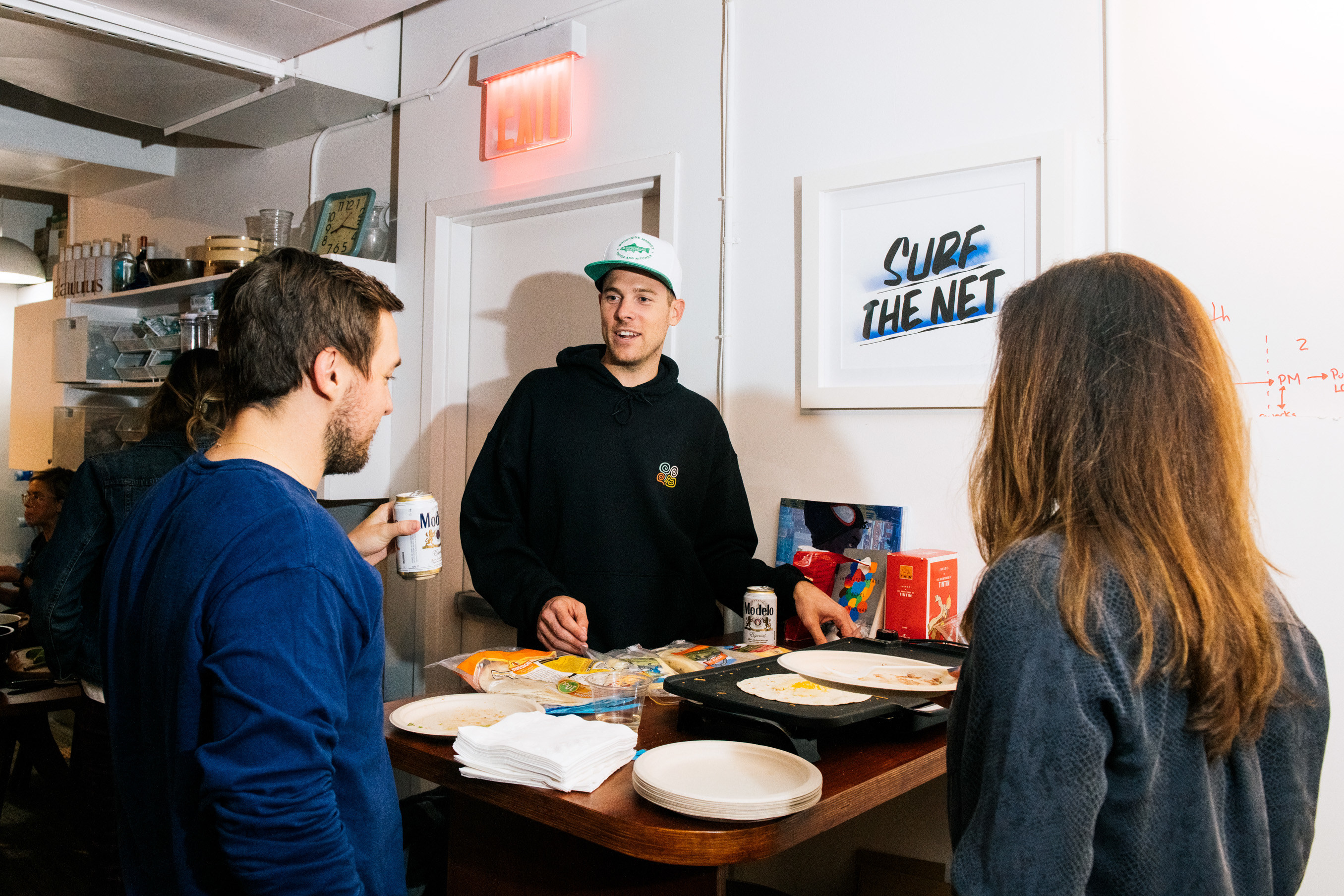
The first time Emmett Shine remembers feeling like everything was out of control and overwhelming, it was the 1990s; he was in junior high, and his parents had just separated.
“I had to start working to support me and my family,” he told me. “My way of dealing with tough stuff was just working. In America, that’s conditioned: If you want to get out of something tough, you just work your way through it.”
Shine, who just turned 36, grew up in the Hamptons — but think more working-class Long Island, less celebrity summer palace. His mom was an artist; his dad was a fisherman and, eventually, a landscaper. Shine was diagnosed with Tourette’s syndrome in the second grade and ended up in a mix of special education and what he refers to as “smart kid” classes. When his parents got divorced, he had to balance work and school. “My friends helped me with food, money, everything,” he said. “Being poor is universal, and it universally sucks.”
Shine looks like any number of white kids I grew up with in Idaho, with a boyish crew cut and an omnipresent baseball cap. The night before, he had shown up at the Equal Parts party wearing shiny, knee-length basketball shorts. “Sometimes I dress like I’m in sixth grade,” he joked, before telling me, in all seriousness, that he sometimes wakes up in the middle of the night and searches for No Fear shirts on eBay.
But the packaging is deceiving. Part of Shine’s charm is that he’s not slick and he doesn’t glad-hand. His sentences come out in paragraphs, with a winding intricacy that often makes sense only when transcribed, read once, then read again. He’s bad at sound bites, bad at short interviews, bad at Twitter. “I was talking to someone last night,” he told me, “and he said that he’d listened to me on a podcast talking about Pattern and was like, ‘I finally get it!’ And I was like, fuck, it took them an hour and a half?”

Shine’s official title at Pattern is “executive creative director,” which still doesn’t adequately convey how much of the company’s aesthetic and attitude — and how much of Gin Lane’s success, which laid the groundwork for it — has sprung from his cavernous, curious mind. The first time I sat down with him, he quoted from Jenny Odell’s How to Do Nothing and Malcolm Harris’s Kids These Days and Jia Tolentino’s work on millennial optimization in Trick Mirror. This is impressive not just because those books are good, which they are, but because I’ve encountered so few people in his position of corporate power who actually do the reading. But Shine’s current thing — and, by extension, Pattern’s thing — is introspection: trying to figure out why he, and the rest of the millennials he works with, feel the way they do even amid profound, seemingly unending success.
Shine’s current thing — and, by extension, Pattern’s thing — is introspection: trying to figure out why he, and the rest of the millennials he works with, feel the way they do.
When Shine graduated from high school, he said, college “wasn’t even in the cards.” But one of Shine’s mentors advised him: You’re a smart guy. You need to get away from here, or you’ll never leave. Shine took his savings and bought a ticket for the place that was the farthest away from Southampton he could find: New Zealand. It was the first time he’d left the country.
It was October 2001. Shine got a camera. He took photos. His mom told him he should think about applying to college, but he only wanted to be in New York City, where, growing up, he’d ride the Long Island Rail Road in to skateboard with his friends. He got into the Tisch School of Arts at NYU, and, upon returning, slowly integrated into the art world of downtown — and began to take on tens of thousands of dollars in student debt. He dropped out before his senior year and started working as a graphic designer for Rocawear; on the side, he ran a photography business. He worked with smaller artists and avant garde designers, and helped promote art shows — work that, over time, would develop into the agency that officially became Gin Lane in 2008.
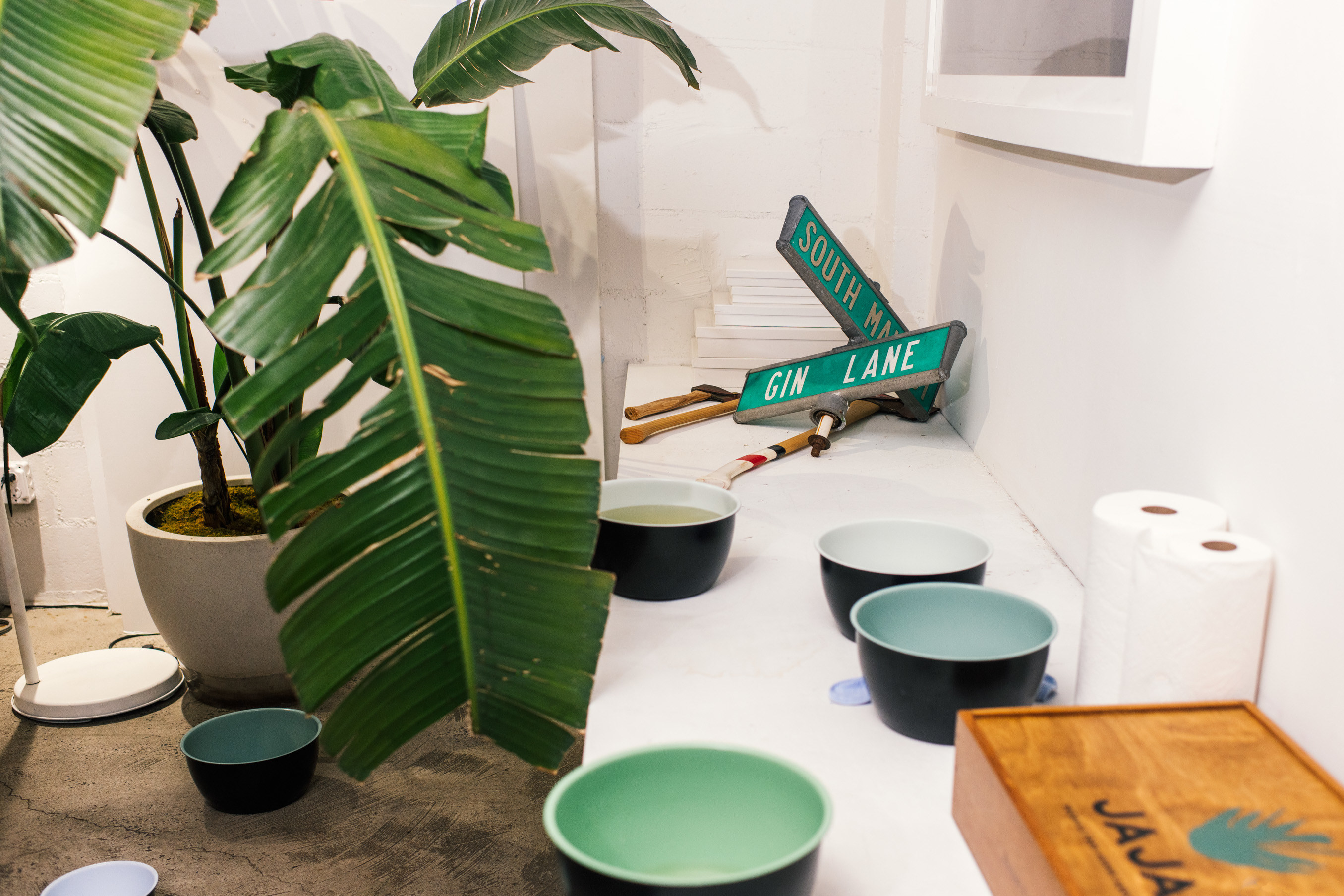
And he was working all the time. “I would sleep in the office,” Shine recalled. “It was classic brogrammer culture, like, in our twenties: You work, then you drink some beer afterwards, eat some Cheetos, order in.” They had a shower in the office, which made it even easier for the 10 or so employees to never leave. “It was just a bunch of people in their twenties who were lost and would find themselves through work.”
It wasn’t until around 2013 that things began to change. Gin Lane hired an account manager, Suze Dowling, and a CEO, Nicholas Ling. “Because I’ve been working for myself since I was a teenager, I didn’t always have people to hold me accountable,” Shine said. “I’m a man-boy in certain regards. But when Suze and Nick got involved, the place professionalized.” Or, at least, there was no more sleeping at the office.

Ling, age 34, has foppish chestnut brown hair in the tradition of a young Hugh Grant, and a posh British accent to match. But the accent, he admits, is learned. He grew up solidly middle class in the suburbs of London, where his mother was a schoolteacher and his father was an accountant. He’d eventually end up at Oxford, completing a degree in physics, but only because he tested into an elite school when he was 11. After graduating, he signed on for what he calls a “very traditional job” with the Boston Consulting Group.
Ling’s arrival at Gin Lane was part of the company’s second life, as it transitioned from a company that worked primarily with artists to one that worked with and for consumer brands, producing the marketing strategy that would introduce them to the world — or, in business-speak, “bring them to market.” In practice, that meant creating the client’s aesthetic, vibe, and messaging — the fonts, the subway ads, the slogans, the social media strategy.
“We had this ability to make things that aren’t cool, cool.”
In 2010, the team helped launch Stella McCartney for Adidas, which led to work for Warby Parker, which then asked them to launch their new venture: Harry’s, a direct-to-consumer shaving company that, like so many of the products Gin Lane would help popularize, was positioned less as a brand and more as a lifestyle choice. Same for Everlane, Bonobos, Sweetgreen, denim brand AYR, Hims, Recess, Alma, Dia & Co — the list of names that now haunt your Instagram feeds, largely thanks to Gin Lane, feels endless.
“We had this ability to make things that aren’t cool, cool,” Ling explained. They used the same general alchemy when approaching something like Harry’s razors as they did when designing the campaign for the plus-size styling service Dia & Co. But the better they got at it, the less invested they became. Shine rattled off what they become known for: “You know, clean aesthetics, bold sans serifs, color blocking.”
“What’s the reason people stay doing something?” Ling asked me. “The challenge. Either that or they believe in something so much that they will smash their head against the wall until they get through. Eventually neither of those was completely true for us.”

It didn’t add up to something, other than what Ling calls “massive spikes of uncontrollable stress.” The work, sure, they could control. In childhood, at school, the work was always the easy part. It was the stuff outside of work that made everything seem untenable. Specifically, Ling’s mother has been chronically ill for the last 20 years. During one of the most stressful periods at Gin Lane, her leg was amputated. Earlier this year, she survived three strokes over the course of six months. And it felt like there was nothing Ling could do about it.
Millennials have been trained to optimize themselves through any struggle, work through any problem. But it was becoming increasingly apparent that work and efficiency couldn’t fix everything. And Ling and Shine weren’t the only ones who felt that way. Despite the demand for their services, they’d kept Gin Lane purposefully small — just under 30 employees. They didn’t expand to meet demand; they just got more particular about what they agreed to do. The senior leadership had all been with the company for at least five years — and two of them, Camille Baldwin and Dan Kenger, were about to get married. As a result, the company managed to maintain the feel of a small startup or, as Shine thinks of it, an “organism.”
“There’s an innate biological clock,” he said, “and you know when it’s time to shift or change or move. People are like, ‘how did you get your team to buy in on this change? And it wasn’t that we got them to buy in. I think the collective organism was searching.”
People were, well, growing up. Getting married, getting pregnant, getting exhausted. The decision to transition from Gin Lane into Pattern “never felt like a whiteboard session in a meeting,” Ling said. “More of, like, a group of friends talking about what motivates us, what’s happening in our lives, as much as what’s the strategy for the company.”
“We were just trying to be happy.”
It was never them thinking Oh, we feel burned out, we need to solve it. It was Ling talking about cooking, and what it did for him, all the time. Camille kept bringing up Benjamin Franklin’s “13 virtues.” Shine couldn’t shake the feeling that he was like Abe Simpson in The Simpsons: an old man shaking his fist at the cloud, but with no idea what, exactly, he was so anxious and angry about. They kept talking about how they had no skills, no hobbies.
They knew they wanted to do more than just launch a product — they wanted to create it, and control where it went. But they also wanted it to be bigger than a gadget, an app, or a food item.
“We were just trying to be happy,” Shine said. “We were always presenting a good face, and everyone was telling us that we have it so good — but internally there’s just something nagging at you.” They didn’t want to feel the way they’d felt the last decade of their working lives. So they started over.
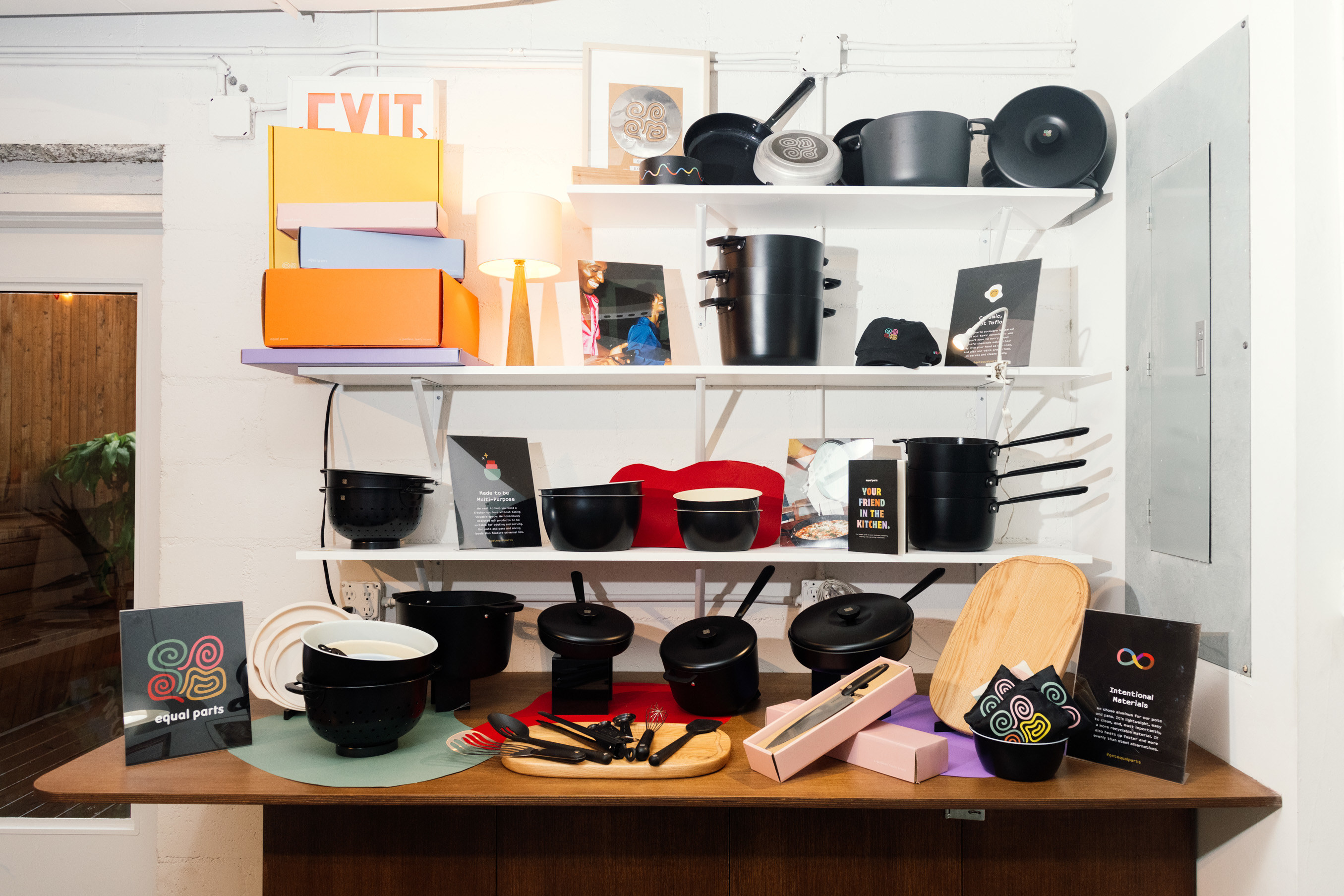
Outside the door to Pattern’s office, there’s a stack of skateboards; mixed-media posters on the walls bear messages like “What if the future could be more human / Embrace that we’re just sapiens.” A felt message board invites visitors to ENJOY DAILY LIFE. Inside, the office is peak millennial: exposed brick walls, snack cabinets, employees with laptops slouching on couches.
“We were trying to make the knife feel like EVE, from Wall-E,” Shine told me, as we hovered near the office’s display of Equal Parts cookware. “We’re trying to make it approachable. It’s German steel, which is good quality, but there’s one that’s ‘above,’ that’s Damascus steel — but you know, it kinda just looked…Dothraki?” (As in Game of Thrones.) “This one, it has a good center of balance. It’s light.”
He gestured toward the cutting board, which I’d seen in action the night before at the launch party. “It’s solid oak. You can flip it over and use it as a charcuterie board or whatever. It’s like a two-and-one for small spaces.” The cookware is lined with ceramic, which is more stylish than the Teflon-coated stuff most of us buy at Target. It works on convection ovens and standard ones. The cores are aluminum, which makes it more recyclable. It’s all machine washable.
For now, the Equal Parts cookware line is available only in a variety of preset combinations, at price points ranging from $79 for just the EVE-like knife (with coaching included) to $499 for the “complete kitchen.” (For comparison’s sake, an 83-piece kitchen set at Wal-Mart currently retails for $69.97 and includes plates and cutlery. It’s also of significantly lower quality.) This equipment is not cheap, but it’s also not Le Creuset or All-Clad expensive. The imagined customers are people in professional jobs who either want to 1) stock a kitchen for the first time or 2) stock a kitchen like a professional adult for the first time. They’re the sort of people who, instead of stopping in at Williams Sonoma or Target, buy things off Instagram ads — and who responded to the products that Pattern, in its previous life as Gin Lane, specialized in making appealing. An Equal Parts set would be a cool-relative college graduation gift, a generous wedding gift, a “dude deciding he makes enough money to stop eating Easy Mac” gift to himself.
Basically, the brand is marketing to people like Shine. His Instagram account features shots of him sautéing onions and putting together a simple pasta using Equal Parts, proud in the charming manner of a true novice. Cooking never interested him. What did interest him was how Ling talked about it. When Ling’s mom was in the hospital, he’d only speak to her and the rest of his family in the mornings, because of the five-hour time difference between the UK and New York. And that meant there was nothing he could do, at least for his mom, in those hours after work.
“I was like, how do I manage the feelings I’m having?” Ling explained. “That’s when cooking became a very central thing for me, just in terms of being able to relax.”
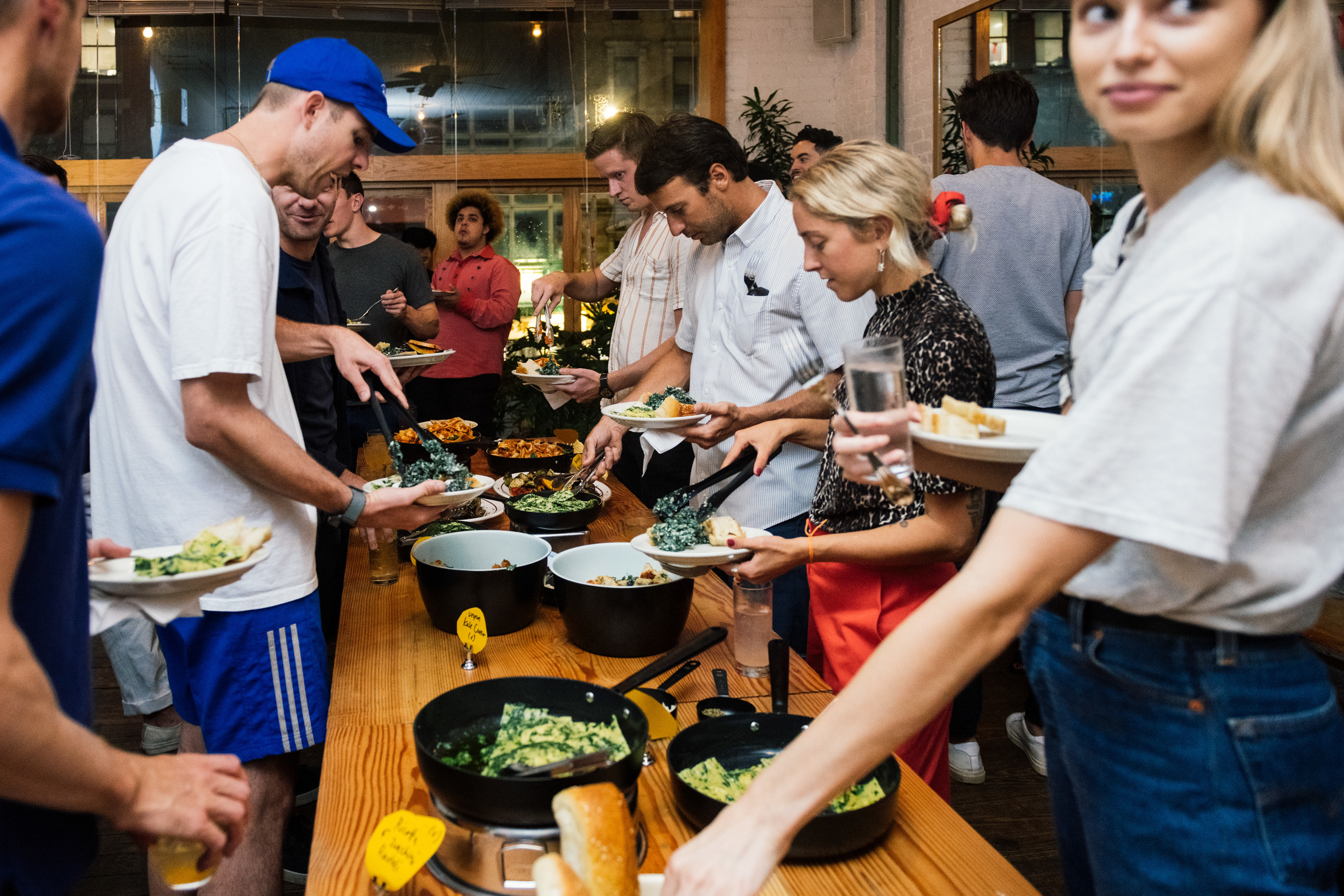
This wasn’t cooking to save money, or to eat healthier, or through a meal-planning service like Blue Apron. It was cooking even when it was ugly, or when it went wrong. It was cooking just to cook. It felt like an antidote, or at the very least, a form of resistance to the feeling that everything you do in your life should be optimized, or monetized, or packaged for social media.
As millennials, “we’ve been trained to do as much as possible, get into the best school possible,” Shine told me. “And that eliminates a lot of ‘unproductive’ free time.” Time spent exploring, goofing off, staring at the wall and listening to music, just hanging out with your own mind — all of that becomes implicitly devalued.
It felt like an antidote, or at the very least, a form of resistance to the feeling that everything you do in your life should be optimized.
“You work on this 18-year-résumé to go this ‘signaling school,’ which your parents, your teachers, your guidance counselor, and everyone else told you that you have to go to, and then you come out 30, 50, 60, 100 thousand dollars–plus in debt,” Shine continued. “And you need to earn a certain amount to pay down your debt, which you might never get rid of, even if you work your entire life. ... And that’s how you find yourself at 27, 28, 29, just like I did, and you have no discernible life skills, except knowing how to work.”
Whatever passions you do have, they’re enveloped by work. “Ten, 15 years ago, they started creating these workplaces to promote productivity,” Shine said. “But they made work the place you go to, to hang out and not be productive. So then to finish the expected productivity, you actually have to take it home.” When you can do work anywhere, you feel the compulsion to do it everywhere — and all the time.
“I didn’t skateboard or surf in my twenties,” Shine said. “I didn’t work out. I didn’t travel.” He joked that it took getting a girlfriend from Denmark to actually start having hobbies again, but it’s not really a joke at all. The story is devastatingly familiar: I’m still trying to recover some semblance of the hobbies that, as an Elder Millennial, I’d cultivated before transforming myself into a work robot.
And yes, sure, a millennial might Instagram themselves baking — when they do it once a month. And those who can afford to, “love” to travel often do it for 36 hours at a time, documenting themselves the entire time as people “who love to travel.” What Shine and Ling envisioned was a more holistic change in, well, the pattern of daily life. Cooking, especially given Ling’s experience with it, felt like the place to start.
“We’re trying to be approachable, attainable, regular, routine,” Ling explained. “It’s not saying you have to do it five nights a week. It’s more like, how can we help this become the rhythm of your life?”
“It’s not saying you have to do it five nights a week. It’s more like, how can we help this become the rhythm of your life?”
They’re trying to cultivate something for millennials that some younger people seem to grasp intuitively: what blogger Venkatesh Rao calls “domestic cozy.” Rao coined the term to describe “an attitude, emerging socioeconomic posture, and aesthetic,” organic to Gen Z, which “finds its best expression in privacy, among friends, rather than in public, among strangers. It prioritizes the needs of the actor rather than the expectations of the spectator. It seeks to predictably control a small, closed environment rather than gamble in a large, open one. It presents a WYSIWYG facade to those granted access rather than performing in the theater of optics.”
Domestic cozy focuses on the cultivation of pleasure for pleasure’s sake, rather than the performance of pleasure. It retreats from the harsh, combative, hyper-political world, rather than engaging it. You can see the manifestations of domestic cozy life all over: in the popularity of Minecraft, in knitting (but not things to sell!), and in a new “inactive wear" company that markets big, pillowy garments to “improve quality of life in the home.”
That’s where Equal Parts fits in: cookware that makes cooking enjoyable for you, personally — nice to use and nice to look at, but not designed with Instagramming in mind. It’s a starter kit, with a low barrier to entry, especially when paired with a cooking coach who communicates with you via text.
When you “onboard” with the service, you answer a bunch of questions: What day do you shop for groceries? What’s your level of skill or ambition? What are your dietary preferences? Then the coach knows when to text, when you need support, how to provide the sort of tips that’ll actually be useful. The coaches aren’t chefs, just people who love to cook — and they’re all boomers, many recruited from cooking schools, from a broad range of backgrounds across the United States. It’s not unlike having a mom-like figure on call to text you tips, only without the baggage of actually texting with your mom.
“We don’t want our coaches to send people recipes,” Ling said. “That’s the antithesis of what we want them to do. They can be like, ‘Hey, what have you got in your kitchen? And then say, ‘Here’s what you could do with what you’ve got, and here’s what you could do if you got one or two extra things.’ Or they’ll send a text that says, ‘Hey, you’re on your way home. You’re feeling tired. Send me a text and tell me how you’re feeling about dinner.’” Those interactions aren’t oriented toward a specific type of meal prep, but getting over mental barriers that keep you from doing things you actually want to do.
Sure, it’s a bougie solution to a bougie problem. A lot of people who are burned out, especially those who aren’t part of the so-called professional class, don’t have the luxury or time to cook for sustenance, let alone fun or relaxation. But one of the things that Pattern is bullish on is that the bougieness doesn’t obviate the problem-ness. You can maintain perspective — you’re not starving, you have a place to live, you have electricity — and also want things to be, or feel, different.
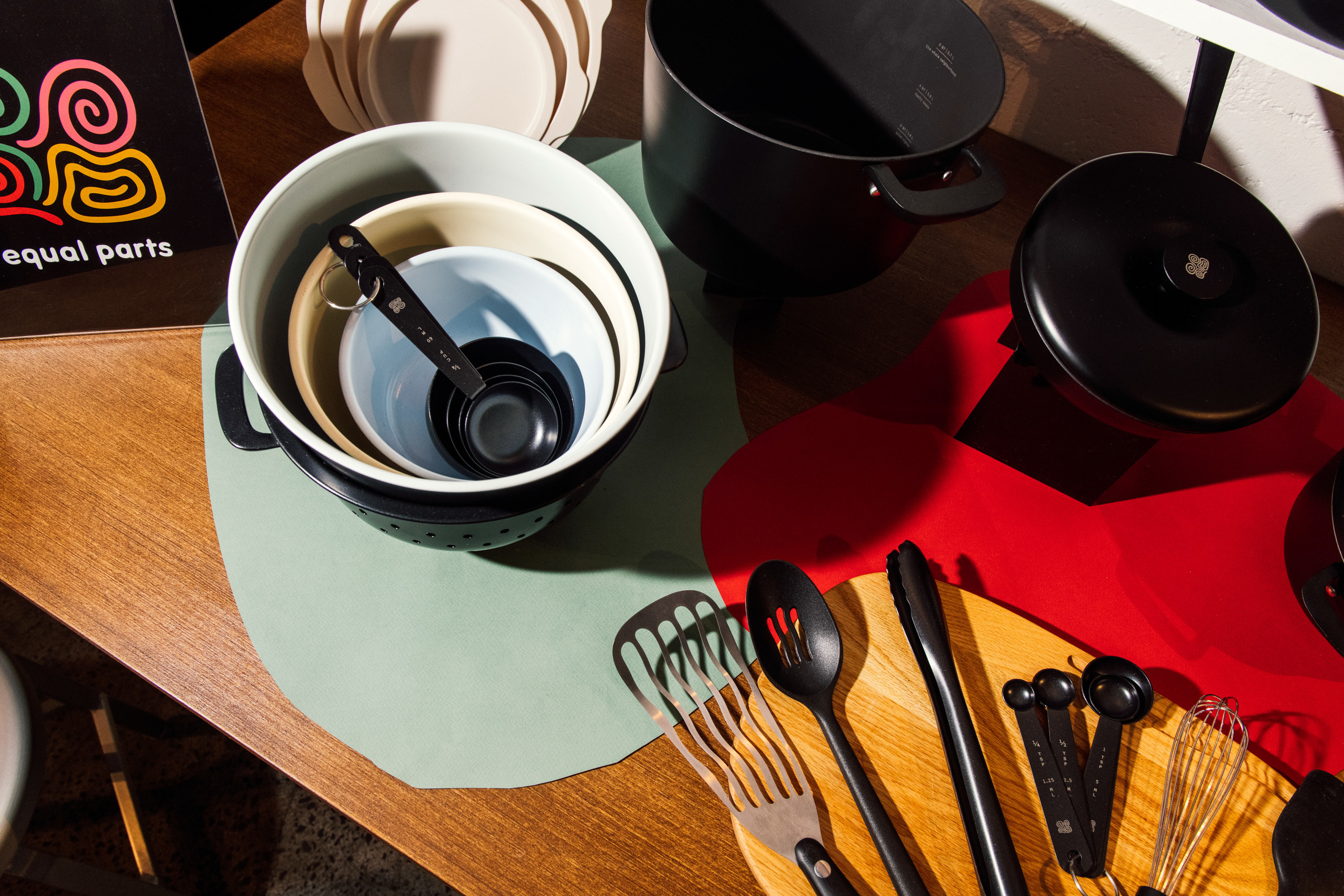
The day before I was set to visit Pattern’s office, I received an email from a youth-trend forecasting company called Cassandra, a division of the global marketing firm Engine. Over the summer, they’d shifted the focus of their quarterly report from “Free Time” to the more pointed “Burnout,” asking questions about how burnout affects daily life and consumer habits among focus groups across the country. The specific findings of the report are behind a paywall, accessible only to brands eager to know how they can begin to pivot to accommodate their customers, and attract new ones, in the months and years to come.
Back in 2015, Cassandra published a similar report focusing on “wellness” — predicting that the new millennial focus would shift, even ahead of the 2016 presidential election, to various elements of what’s become known as “self-care”: in diet, in skincare, in mental health. They’re predicting a similar wave with burnout, which, according to their findings, is already cutting across class, race, and urban/rural/suburban demographics. As Melanie Shreffler, one of Cassandra’s VPs, told me, “Burnout is the green juice of 2019.”
When I told the authors of the report about Pattern, they said that it was “on the tip of the spear” — the sort of brand with which so many others, especially the less nimble ones, would soon find themselves playing a clumsy game of catch-up. But if anti-burnout marketing is poised to become mainstream, brands like Pattern can quickly come to feel exploitative.
After all, our current iteration of capitalism can’t fix the problems that our current iteration of capitalism has wrought. If we’ve learned anything from all the millennial-oriented books on how to unfuck your life, the meditation apps, the organizational apps, and the profusion of $3,000 exercise bikes, it’s that a thing can’t fix what ails both millennials and society as a whole. Maybe Pattern’s pivot to anti-burnout philosophy is just its way of being, once again, perfectly (and profitably) attuned to millennials’ desires.
When I laid out this argument to Shine and Ling, they shook their heads. “I’d rather be accused of being dumb than having malicious intent,” Shine told me. “The way we got to what we got to with Pattern was a form of self-therapy.”
"I’m gonna try and say this in a way that isn’t like, pullquote-y and bad, but I think we found ourselves in a good wave position.”
“Listen,” he continued, the frustration palpable in his voice. “I like surfing. I like waves. Look around and you’ll see pictures of waves everywhere in this office. If you go on Wikipedia and you type in waves, it’s all math. The entire universe is constructed of waves. If you’re surfing, and you’re ahead of the wave, you get toppled over. If your ratios are behind the wave, it just goes underneath you, and you can’t catch it. And I’m gonna try and say this in a way that isn’t like, pullquote-y and bad, but I think we found ourselves in a good wave position.”
The goal for Pattern is not to move fast and break things in order to disrupt cooking — after all, there’s no shortage of direct-to-consumer kitchenware brands already on the market — but to create something meaningful in the long term. “The number one thing is just for us to keep raising awareness,” Shine continued. “And if we can provide solutions, then that’s a bonus. Of course we have to, like, build a sustainable business that makes sense and makes money. That’s gonna take a long time, and we know that. There’s no expectation of, like, a quarterly return. We’re in it for seven to 10 years, minimum.”
Earlier in our conversation, Shine had brought up what he saw as the three pillars of contemporary American society — the three areas where you can affect change: within the community, in politics, and within markets.
“I just keep going back to the fact that I am not a community organizer,” he said. “I am not a politician. I am a goddamn marketer. And I’m good at it! So why shouldn’t I use what I’m good at for what I think will make things one step better, not one step worse?”
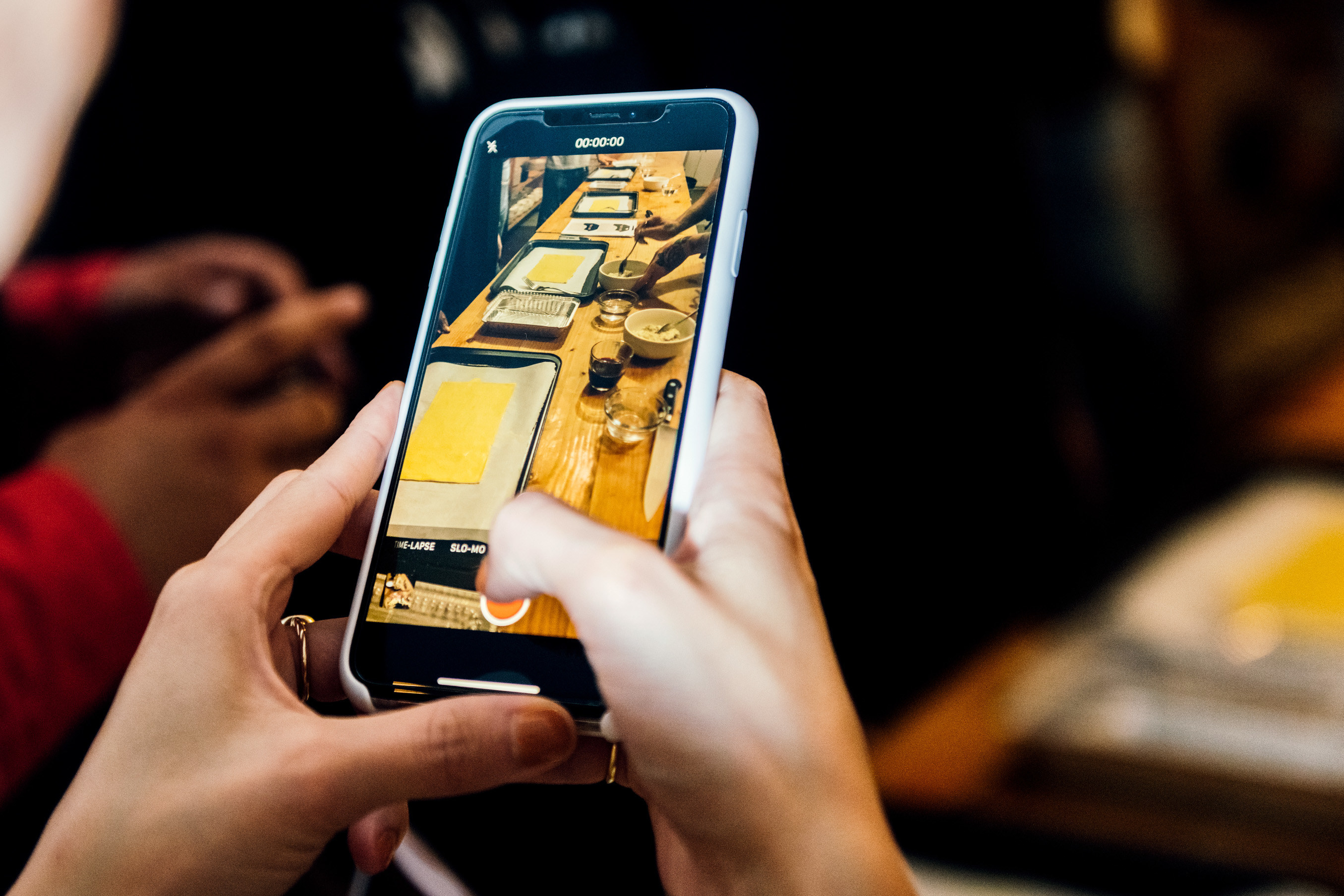
Shine’s argument is reminiscent of recent conversations about various presidential candidates on the progressive left: Can a candidate like Elizabeth Warren, who’s open about believing in markets while also advocating for meaningful, systemic moderation of those markets, actually create change? Is antipathy toward capitalism, and true socialist ideals, the only real solution? Or, given the reality of the political and economic realities of the country, is the most productive change made by renovating the existing system?
The team at Pattern understood that if they were going to try and market this sort of from-the-inside change to a mass audience, they needed to reflect it themselves: individually, but also as a company. Because that’s the other reason for the disillusionment with companies that market themselves with a philosophy, from social justice to feminism. When you treat your women employees like garbage, it doesn’t matter how many feminist T-shirts you sell: You’re not a feminist company. When you keep hiring white men for positions of power, invocations of social justice become meaningless.
That means an anti-burnout company can’t be burning out its employees. On the HR side of things at Pattern, that translates to 20 days of PTO, 10 of which are mandatory; completely closing down the office between Christmas and New Year’s; 12 weeks fully-paid leave for primary caregiver leave and 6 weeks to secondary caregivers; flexible scheduling for parents; cultivating a 6 o’clock end to the workday, with Shine and Ling leading by example. Their sacred text is “Pattern’s 10 Simple Steps to Help You Enjoy Daily Life,” which includes “Do one thing at a time,” “Each morning, do something before checking your phone,” “Let your mind wander,” “Take control of your leisure time,” and “Embrace mediocrity.”
An anti-burnout company can’t be burning out its employees.
Every week since launching this summer, the company has oriented itself toward one of those 10 steps; at their weekly meeting, Shine and Ling share their own experiences and failures with each. If an employee shares their personal experience on Slack, they get a raffle ticket for a weekly drawing for, wait for it, a houseplant. When Pattern posted the 10 Simple Steps on its Instagram, the post was “saved” twice as many times as it was shared or liked: proof, Ling says, that it’s maybe, actually, meaningfully useful.
Pattern proclaims that it’s guided by five core values — which, as the company’s website states, “represent our character, our process, and how we push ourselves to be better.” Some of them are easy: hospitality, curiosity, acceptance. But others are a struggle, or at the very least an area for constant improvement. “Responsibility” means considering the impact of their products not only on the people who buy them, but the people who make them — which, in turn, makes the product more expensive, and/or the profit margin smaller. (When I asked if depending on venture capital might eventually put pressure on the team to focus more on profit and less on principles, Shine and Ling told me in an email that their investors “fully support the time and energy we spend everyday on internal culture and making Pattern a great place to work.”)
And then there’s “Equity.” Each Pattern brand will dedicate 1% of its revenue to a local nonprofit organization (for Equal Parts, it’s the Chinatown-based Two Bridges Neighborhood Council). Shine and Ling also foresee themselves working for and collaborating with politicians who aim to address financial inequality. But the staff, at least in its current iteration, is very white — something that, when the first publicity photos of the staff went public, attracted attention. They’re also very international, and hail from a range of economic and educational backgrounds. But for Pattern to meaningful address what “enjoying daily life” might look like for all different sorts of people, they need those sorts of people in the company as well. In other words, there’s still a lot of “equity” work to do.
Shine and Ling are cagey on the exact identity of the next Pattern brand, set to launch in early 2020. It might be something that helps people learn to sew just to sew, but also to make the things you own last longer. Or products to help people do simple handy tasks around the home, not because you want to make it look like a West Elm catalog, but because there’s pleasure in getting something done yourself — rather than looking at the framed piece of art, still on the floor after two years in your apartment, shaming you every morning on your way out the door. The only real stipulations are that it has to make money, and it has to be part of the company’s overall mission to help others “enjoy daily life.”
“I was looking at this Ernst and Young report about how they’re helping people manage their workplace habits better during peak season for accounting,” Ling said. “And I was thinking, why does that feel like it’s really going to make a difference? You know, Ernst and Young, they’re a great company, I’m sure. But not everything about their being is going to catalyze that change. Everything about their being is going towards whatever their mission statement is — like, making sure people have good accounting practices, or whatever. Which is why I think you need companies like Pattern at the center of things like this — to set the standard that we will drag other people to.”
That’s Pattern’s answer to the critique that cookware won’t fix burnout — especially cookware at a price point that’s only available to a particular type of consumer. The cookware isn’t really the point. The overarching Pattern brand, and what it represents, is the point. In her newsletter write-up of Pattern’s launch, marketing analyst Emily Singer pinpointed this exact tension: “I hope that [Pattern] finds way for people who are not customers to engage with the brand,” she wrote. “Its message is meaningful and universally applicable. It would be a shame if the only way to access it was through a transaction.”
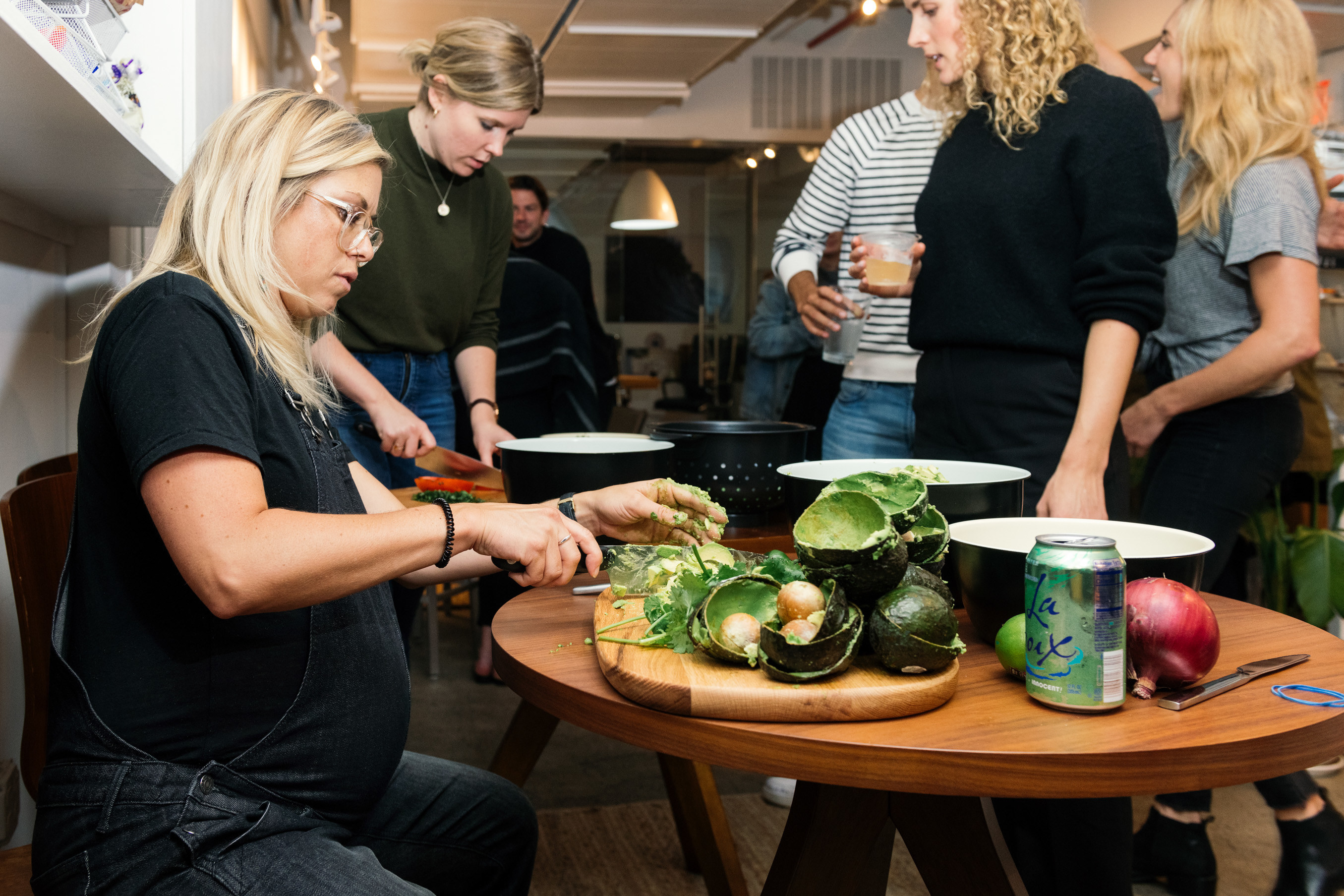
At precisely 5 p.m. on the day of my visit to Pattern’s office, the sound of jazz began to filter into the conference room where we were finishing our interview. The rest of the team began to slowly transition from their workplace postures: Some started pouring a low-alcohol aperitif, previously launched by Gin Lane, that’s marketed toward people who wanted to be social but not get wasted. Camille, pregnant in overalls, peeled an unending supply of avocados on the Equal Parts cutting board using the Equal Parts knife. (When I tried to get in touch with a few follow-up questions for her this month, she’d just given birth — and was really and truly off email.)
Everyone at Pattern told me they loved working there — what else would they tell a journalist covering their newly launched company? But they offered convincing testimonies, and not just from the leadership suite: One employee had worked for a startup “industry disrupter” with ads currently blanketing the New York subway; the management and work-life balance was so toxic that Pattern’s philosophy and policy still felt mildly shocking. A new employee, on the job for just three months, was amazed the office actually cleared out at 6 pm. The mom of a toddler twirling around in an office chair told me that her daughter’s presence in the office at that moment is indicative of the Pattern culture. There’s no compunction to pretend that children have no effect on your life, your schedule, or the number of days you have to work from home. Having a kid doesn’t make you a worse worker, or a less attentive one. It just makes you a parent.
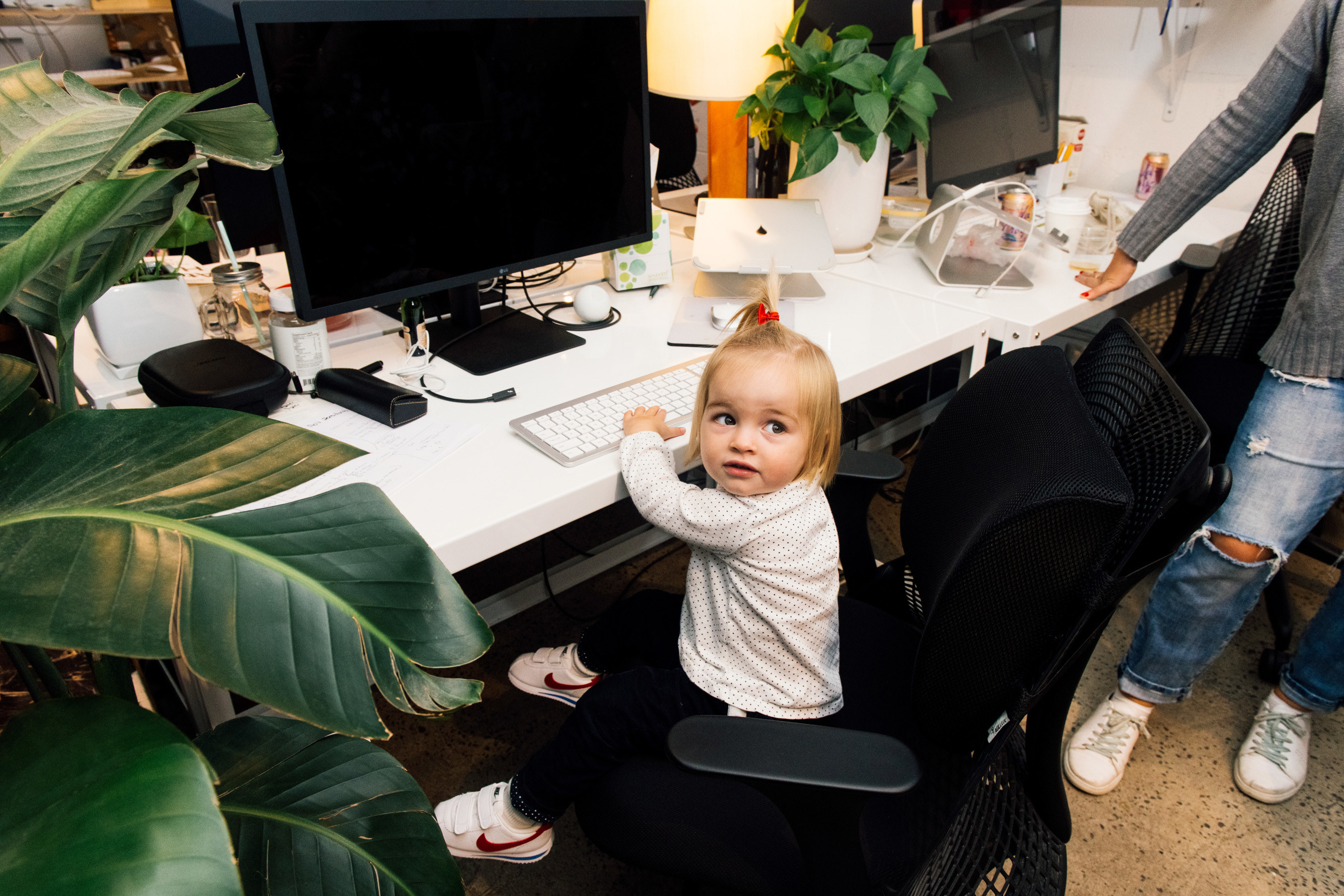
I walked home to my hotel that night in the rain, flicking at my phone, barely avoiding the traffic on Bowery. Every time I come back to New York, so, too, do all of my worst burnout habits. I stayed up too late scrolling Instagram; I woke up too early; I never drank enough water. The year before, I’d stumbled around the city after working so hard, and flying so much, that I gave myself a case of vertigo that lasted for 10 days.
This time, I tried to be better. I’d gone to SoulCycle for the first time, thinking it might center me. I left feeling mostly just wet. I ate the same Sweetgreen salad for two meals a row. They tasted like robot food, like nothing at all. I realized, when I got home, that I’d left my planner in the Pattern conference room. I emailed in a panic: “It’s the only thing keeping my life together.” They sent it to me the next day, and I opened the package and began to stroke it like it was a lost sacred artifact.
How can we actually change the patterns of our lives — in a way that accommodates their current complexities without capitulating to them?
What holds your life together? What keeps us going? What if it were a daily practice instead of a planner? How can we actually change the patterns of our lives — in a way that accommodates their current complexities without capitulating to them?
When I flew home to Montana, there was an email from Shine waiting. He rarely talked about his childhood in a public way, he said, and our conversation had loosened some threads he wanted to tie back together. Pattern is, in many ways, a way to redo so much of what he missed: “Making brands to teach myself and people around me the life skills I think so many of us missed, trying to make seeking balance cool, being present cool, and working like a dog to survive not as cool.”
That circles back to Shine’s understanding of how change actually happens: Community leaders advocate. Politicians draft and pass regulations and legislation. And the market helps shape the way the public feels and thinks: They make things seem cool and uncool, defensible and indefensible, right and wrong, the future and the past.
Pattern’s Equal Parts brand might, at best, make it cooler to cook for cooking’s sake — might help create personal change. But there’s also a chance that Pattern, alongside other anti-burnout, pro-sustainability industry leaders like Patagonia, might make their vision of corporate culture cool. And if they can change the way other companies conceive of work, and prove that their model creates a better outcome for everyone involved — that won’t bring down the system, but it has the potential to help make living in it more bearable.
I typed that sentence and impulsively opened Instagram. Whoever is running Pattern’s Instagram account has just liked a photo of my dog. The sun is bright outside the window, the sky the clearest October blue. In a few minutes, I’ll close the laptop, and forget my phone, and walk out the front door and into the woods along the creek, with nothing to listen to and nowhere to be.
Later, I’ll come home and make something for dinner that’s ugly but tastes good. It won’t be with Equal Parts cookware, but I don’t think Shine and Ling would mind. I’ll have a thought, and I won’t tweet it. I’ll take a picture, and I won’t post it. I’ll open a book, and I’ll read it. And I’ll tell everyone I know: Did you hear the good news? It’s cool, these days, to enjoy daily life.●
